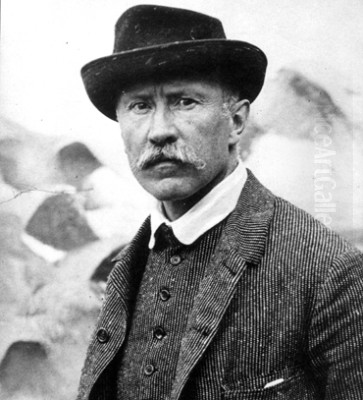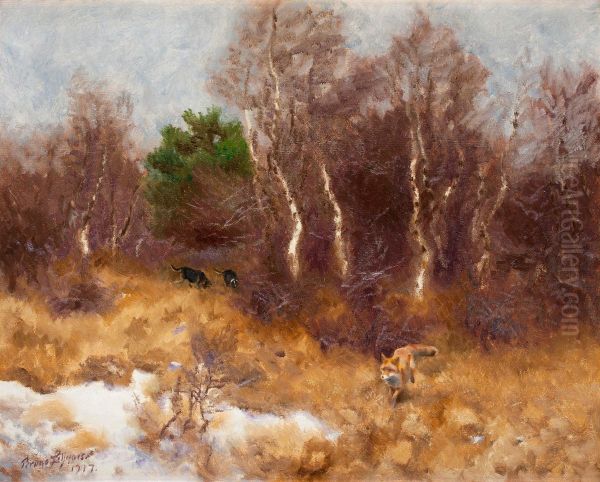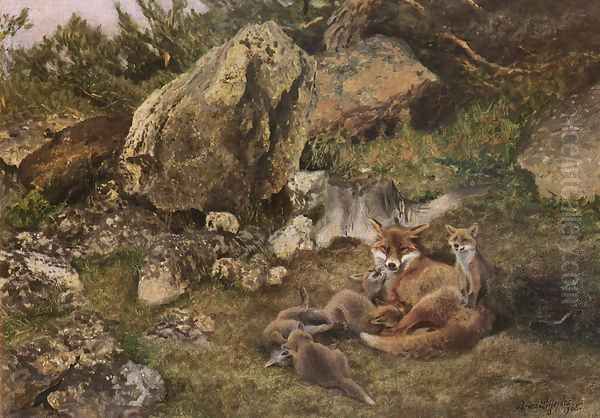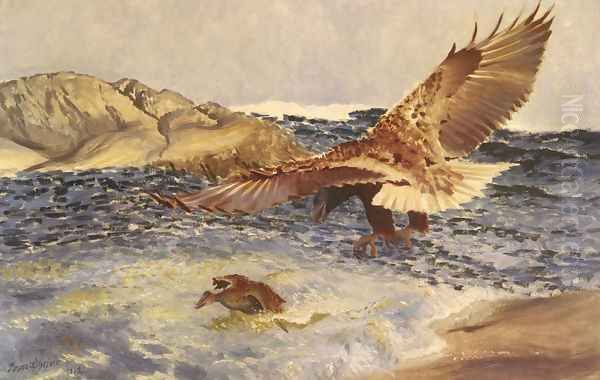
Bruno Andreas Liljefors stands as a towering figure in Swedish art history, renowned primarily as the nation's foremost wildlife painter. Active during the late 19th and early 20th centuries, his life spanned from 1860 to 1939, a period of significant artistic change across Europe. Born in Uppsala, Sweden, Liljefors developed an intense connection with the natural world from a young age, an intimacy that would define his artistic output. He moved beyond mere representation, capturing the essence of animal life – its beauty, its dynamism, and its often brutal reality – with unparalleled skill and insight. His work remains a benchmark for wildlife art, blending keen observation with innovative painterly techniques.
Early Life and Artistic Awakening
Bruno Liljefors's journey into art began with his innate fascination for the landscapes and fauna surrounding his Uppsala home. This early passion led him to formal studies at the Royal Swedish Academy of Fine Arts in Stockholm from 1879 to 1882. However, like many progressive artists of his generation, Liljefors found the academic curriculum stifling and traditional. He sought a more direct, experiential approach to art, one rooted in the observation of life itself rather than prescribed formulas.
His dissatisfaction with the Academy aligned him with a group of like-minded young artists who would soon challenge the established art norms in Sweden. Leaving the Academy, Liljefors embarked on travels that broadened his artistic horizons. He spent time in Düsseldorf, a traditional center for painting, but was perhaps more significantly influenced by his time spent with the Scandinavian artist colony in Grez-sur-Loing, near Paris. There, he absorbed the currents of French Realism and the burgeoning Impressionist movement, which emphasized light, atmosphere, and capturing fleeting moments.
The Essence of the Wild: Subject and Method
Liljefors dedicated his artistic life to depicting animals in their natural habitats. His approach was deeply immersive. He was an avid hunter, not merely for sport, but as a means of understanding animal behavior, anatomy, and their relationship with the environment. This firsthand knowledge infused his paintings with an authenticity rarely seen before. He didn't just paint animals; he painted their lives, their struggles for survival, and their moments of quiet existence within the grand tapestry of nature.

To achieve this realism, Liljefors often worked directly from life. He famously kept a menagerie of animals – including foxes, hares, eagles, and various birds – at his studio homes over the years. This allowed him constant access to his subjects, enabling him to study their movements, postures, and interactions up close. He combined this direct observation with his experiences in the field, using sketches, memory, and sometimes photography as aids to compose his larger studio canvases. His dedication to observing camouflage, movement, and the subtle interplay between predator and prey set his work apart.
Artistic Style: A Fusion of Observation and Modernity
Liljefors's style is a unique synthesis of meticulous realism and modern painterly techniques. The foundation of his work lies in accurate depiction, born from his profound understanding of animal anatomy and ecology. Yet, he was far from being a mere photorealist. He embraced the lessons of Impressionism, particularly in his handling of light and atmosphere. His brushwork could be loose and suggestive, capturing the dappled sunlight filtering through forest leaves or the stark, cold light of a winter landscape.
His compositions often show an awareness of Japanese art principles, which gained popularity in Europe during the late 19th century. This influence can be seen in his sometimes unconventional framing, the use of flattened perspectives, and a focus on pattern and silhouette, particularly in his depictions of birds against the sky or animals blending into foliage. While primarily a realist, elements of Art Nouveau's decorative linearity can occasionally be discerned in his treatment of natural forms. He masterfully balanced scientific accuracy with artistic expression, creating works that were both informative and aesthetically compelling.
Unlike the sentimental animal portraits popularised by artists like Sir Edwin Landseer in Britain, Liljefors presented a more objective, almost Darwinian view of nature. His paintings often depict the stark reality of the food chain – the fox stalking the hare, the hawk striking its prey. Yet, these scenes are rendered without melodrama. Instead, they convey a sense of natural balance, the inherent drama of survival played out within a specific, carefully rendered environment. He captured the tension and dynamism of these moments with incredible skill, influencing how wildlife was portrayed in art.
The Opponents and the Swedish Art Scene
In 1885, Liljefors became associated with the "Opponents" (Opponenterna), a group of 84 Swedish artists who protested against the conservative principles and teaching methods of the Royal Academy. This group, which included prominent figures like Anders Zorn, Carl Larsson, Ernst Josephson, Richard Bergh, and Karl Nordström, organized their own exhibitions, marking a significant turning point in Swedish art history. Liljefors's painting Hound and Fox was featured in their first exhibition, signaling his alignment with the progressive forces seeking greater artistic freedom and realism.

While Zorn became famous for his portraits and depictions of rural life and Larsson for his idyllic domestic scenes, Liljefors carved out his distinct niche in wildlife painting. He shared with his contemporaries an interest in capturing Swedish identity and landscape, contributing to the National Romanticism movement prevalent in Scandinavia at the time. However, his focus remained steadfastly on the non-human inhabitants of that landscape. His contemporaries, like Nils Kreuger of the Varberg School, also focused on landscape and animals, but Liljefors's dedication to the drama of wildlife interaction was unique. Even the multi-talented August Strindberg, known primarily as a writer but also a painter, explored expressive landscapes that contrasted with Liljefors's detailed realism.
Masterworks and Enduring Themes
Liljefors produced a significant body of work throughout his long career. Certain paintings stand out as iconic representations of his style and themes. A Family of Foxes (1886) showcases his ability to depict animals with both accuracy and a sense of familial connection, observed within their den environment. Sea Eagle Chasing Eider Duck captures the raw energy and life-or-death struggle of the predator-prey relationship, set against a dynamic seascape. The sense of rapid movement recalls, in spirit if not style, the attempts by Impressionists like Edgar Degas to capture motion.
Hawk and Black Grouse (1884) is another powerful example of his focus on predation, rendered with dramatic intensity and attention to the textures of feathers and snow. Eluding the Fox presents the tension from the prey's perspective, highlighting the importance of camouflage and alertness for survival. These works demonstrate his consistent themes: the cycle of life and death in nature, the adaptation of animals to their environment, and the beauty found in these often harsh realities. His ability to place these dramas within convincingly rendered Swedish landscapes – forests, coastlines, winter scenes – adds another layer of authenticity and power. He shared a dedication to depicting the realities of rural life and nature seen in French Realists like Gustave Courbet or Barbizon School painters like Jean-François Millet, but focused entirely on the animal kingdom.
Beyond Painting: Illustration and Influence
While best known for his oil paintings, Liljefors also worked as an illustrator and is considered one of Sweden's early comic artists. He created narrative picture series, demonstrating his storytelling abilities extended beyond the single canvas. This aspect of his work, though less famous internationally, contributed to the development of graphic arts in Sweden.

Liljefors's impact extends far beyond his native country. His approach to wildlife painting – combining rigorous observation, ecological understanding, and modern artistic techniques – profoundly influenced subsequent generations of wildlife artists, particularly in North America. Artists like Bob Kuhn and Michael Coleman have acknowledged their debt to Liljefors's pioneering work. He essentially set a new standard for the genre, moving it away from romanticism or purely scientific illustration towards a more dynamic and ecologically informed art form. His international reputation was solidified through exhibitions and the acquisition of his works by major museums, including the Nationalmuseum in Stockholm and the Gothenburg Museum of Art. His influence can be seen as parallel to how Claude Monet influenced landscape painting, setting new ways of seeing and depicting a specific subject matter.
Critical Reception and Legacy
Bruno Liljefors achieved considerable recognition during his lifetime and remains one of Sweden's most celebrated artists. His work was lauded for its technical brilliance, its deep knowledge of nature, and its powerful depictions of wildlife. He was seen as an artist who truly understood and could convey the spirit of the wild. His paintings resonated with a public increasingly interested in nature and national identity during the late 19th and early 20th centuries.
However, his objective, sometimes stark, portrayal of nature wasn't without its critics. Some found his work lacking in overt emotion or sentiment compared to more traditional animal painters. His focus on the predator-prey dynamic, while accurate, could be perceived as cold or detached by viewers accustomed to more anthropomorphized or idealized depictions of animals.
Despite these occasional critiques, Liljefors's legacy is secure. He is widely regarded as the preeminent wildlife painter of his era, not just in Sweden but internationally. His unique fusion of scientific observation and artistic sensibility created a body of work that continues to fascinate and impress. While detailed accounts of his personal interactions with specific contemporaries like Zorn or Larsson, beyond their association in the Opponents group, are scarce, and anecdotes about his private life remain limited in public knowledge, his artistic contribution is monumental.
Conclusion: An Unrivaled Vision of Nature
Bruno Liljefors occupies a unique and vital place in art history. He elevated wildlife painting from a specialized genre to a powerful medium for exploring fundamental themes of life, death, and survival. His deep immersion in the natural world, combined with his mastery of technique and his absorption of contemporary artistic currents like Impressionism and Japanese art, resulted in works of enduring power and authenticity. He provided an unsentimental yet deeply respectful vision of nature, capturing the intricate beauty and inherent drama of the animal kingdom. His influence on subsequent wildlife artists is undeniable, and his paintings remain compelling testaments to the wild spirit he knew so intimately and depicted so brilliantly.